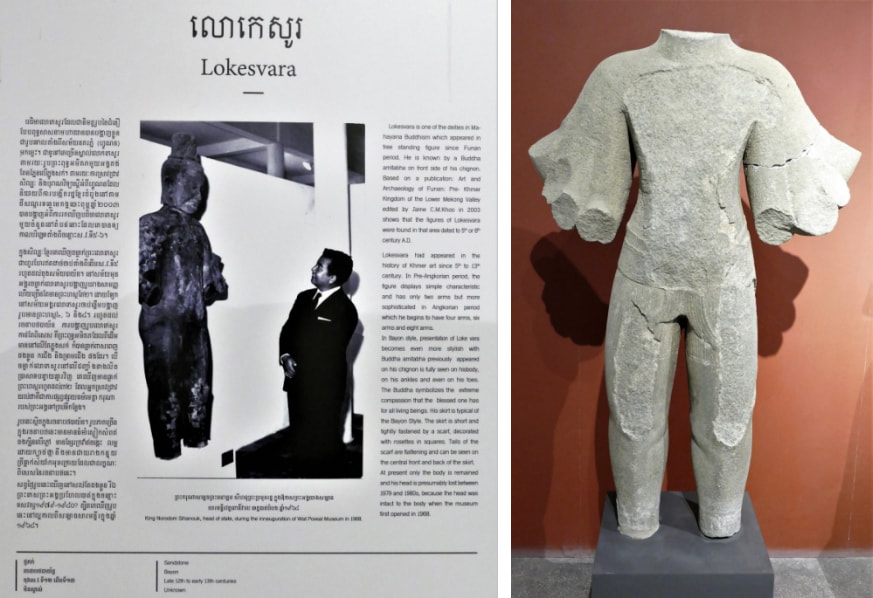|
About two dozen monasteries are located in the city of Battambang. Not every monastery is of interest to tourists, but undeterred art lovers should head east of the river to Wat Po Veal. Behind this beautiful temple stands a low simple from outside rather shabby building with barred windows and doors. Consequently, you can assume that valuables are in the rooms. What else could justify this securing of the building? In fact, Khmer relics are stored in the building. Years ago, monks’ hid irretrievable Khmer art treasures in the monastery and with this courageous action saved them from the Khmer rouge’s fancy of destruction. Despite the fact that a sign above the door promises the Wat Po Veal Museum, the collection remains out of reach. Even after repeated requests, no responsible person revealed himself to open the rooms for viewing. Dirty windows prevent you from looking inside. Fortunately, curious visitors smashed several windows at eye level. You have to appreciate this gratefully; the resulting wholes enable views from outside into the hall. The following four photos show the former museum hall, which was once divided with partitions walls. You can still see the course of a clockwise museum tour. With a bit imagination, you can even understand the former arrangement of the art treasures. Dust and cobwebs hardly disturb the unauthorized look at the treasures, but the unbelievable chaos caused willfully is shocking. Ignoring the deplorable conditions, art lovers look at the neglected collection with gratitude and/or sadness. The photos do not require any comments. The remaining remnants and the cultural-historical value of a collection that was once worth seeing seem to have become worthless and meaningless to the owners. The disregard is a scandal. The collection includes what distinguishes Khmer art: lintels, tympana, acroteria, altars and statues. The author could photographically secure some wonderful lintels. These photos only have documentary value. They show art lovers familiar lintel motifs in best Angkor tradition. The differing Kala representations alone will delight art lovers. The Kala-Indra-Lintel, like the Vishnu-Garuda-Lintel and many other objects from the sealed collection belong in a public museum. Probably, all the existing objects recovered in the past belonged to temples of the Battambang region. Speculations regarding the completeness of the former collection are unnecessary. Barbarians have raged, the chaos is unmistakable. It seems that the owners do not feel responsible for the proper storage of the Khmer art objects. The holder of the collection remains unclear to outsiders. The storage hall, you no longer can call it a museum, is invariably located on the grounds of the Po Veal Monastery. The inmates of the monastery disregard the art treasures. With this desolate impression, interested visitors leave things incompletely done and dissatisfied with the otherwise well-kept monastery. The responsibility of the PATA organization for the collection you also have to assess as low. The collection and its preservation are not advertised anywhere. It would be advisable for the city of Battambang or the State Ministry of Culture to take on the protection, care and representation of the collection. Further neglect of these art objects would equate to their loss. Noted with bitterness the collection is currently lost for the public. In the newly built Provincial Museum Battambang, a display board and one object prove the former existence of the Wat Po Veal Museum. King Norodom Sihanouk was certainly the most prominent guest at Wat Po Veal at the inauguration of the museum in 1968, admiring the Bayon period Lokesvara statue (at that time with head). The excellently equipped new museum in Battambang only presents the headless statue, this object proves that at least one work of art from the Wat Po Veal Museum moved to the Provincial Museum. Note: the photos from the Wat Po Veal Museum show the condition of February 25th, 2022
Photos and text: Günter Schönlein Correction: Vanessa Jones
0 Comments
Leave a Reply. |
Author
|
All rights reserved.
Copyright © 2015 Hor Sopheak & Unique Asia Travel and Tours, Siem Reap, Cambodia
Texts and Photos by Ando Sundermann and Hor Sopheak, unless otherwise stated
with special thanks to contributers Günter Schönlein and Jochen Fellmer
Copyright © 2015 Hor Sopheak & Unique Asia Travel and Tours, Siem Reap, Cambodia
Texts and Photos by Ando Sundermann and Hor Sopheak, unless otherwise stated
with special thanks to contributers Günter Schönlein and Jochen Fellmer









 RSS Feed
RSS Feed
